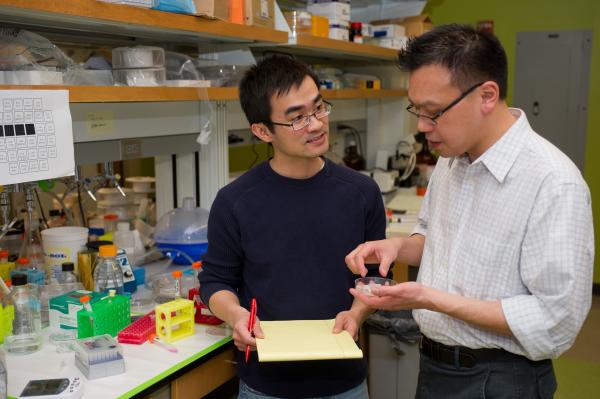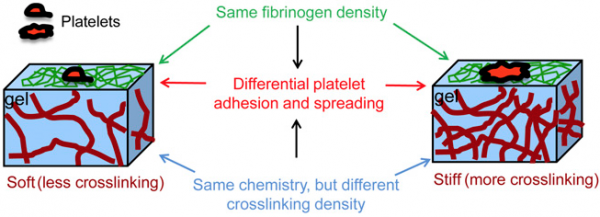Platelets, the tiny cell fragments whose job it is to stop bleeding, are very simple. They don’t have a cell nucleus. But they can “feel” the physical environment around them, researchers at Emory University and Georgia Tech have discovered.
Platelets respond to surfaces with greater stiffness by increasing their stickiness, the degree to which they “turn on” other platelets and other components of the clotting system, the researchers found.
“Platelets are smarter than we give them credit for, in that they are able to sense the physical characteristics of their environment and respond in a graduated way,” said Wilbur Lam, M.D., Ph.D., assistant professor in the Department of Pediatrics at Emory University School of Medicine and in the Wallace H. Coulter Department of Biomedical Engineering at Georgia Tech and Emory University.
The results are published in the journal Proceedings of the National Academy of Sciences. The first author of the paper is research associate Yongzhi Qiu. Lam is also a physician in the Aflac Cancer and Blood Disorders Center, Children’s Healthcare of Atlanta.
The researchers’ findings could influence the design of medical devices, because when platelets grab onto the surfaces of catheters and medical implants, they tend to form clots, a major problem for patient care.
Modifying the stiffness of materials used in these devices could reduce clot formation, the authors suggest. The results could also guide the refinement of blood thinning drugs, which are prescribed to millions to reduce the risk of heart attack or stroke.
The team was able to separate physical and biochemical effects on platelet behavior by forming polymer gels with different degrees of stiffness, and then overlaying them each with the same coating of fibrinogen, a sticky protein critical for blood clotting. Fibrinogen is the precursor for fibrin, which forms a mesh of insoluble strands in a blood clot.
With stiffer gels, platelets spread out more and become more activated. This behavior is most pronounced when the concentration of fibrinogen is relatively low, the researchers found.
“This variability helps to explain platelet behavior in the 3D context of a clot in the body, which can be quite heterogenous in makeup,” Lam said.
Qiu and colleagues were also able to dissect platelet biochemistry by allowing the platelets to adhere and then spread on the various gels under the influence of drugs that interfere with different biochemical steps.
Proteins called integrins, which engage the fibrinogen, and the protein Rac1 are involved in the initial mechanical sensing during adhesion, while myosin and actin, components of the cytoskeleton, are responsible for platelet spreading.
“We found that the initial adhesion and later spreading are separable, because different biochemical pathways are involved in each step,” Lam said. “Our data show that mechanosensing can occur and plays important roles even when the cellular structural building blocks are fairly basic, even when the nucleus is absent.”
The research was supported by the National Science Foundation, the American Heart Association, the National Heart Lung & Blood Institute (U54HL112309, R01HL121264) and the National Eye Institute (PN2EY018244).
Media Relations Contacts: Emory University: Quinn Eastman (qeastma@emory.edu) (404-727-7829) or Georgia Tech: John Toon (jtoon@gatech.edu) (404-894-6986).
Writer: Quinn Eastman
Media Contact
John Toon
Research News
(404) 894-6986
Keywords
Latest BME News
The department rises to the top in biomedical engineering programs for undergraduate education.
Commercialization program in Coulter BME announces project teams who will receive support to get their research to market.
Courses in the Wallace H. Coulter Department of Biomedical Engineering are being reformatted to incorporate AI and machine learning so students are prepared for a data-driven biotech sector.
Influenced by her mother's journey in engineering, Sriya Surapaneni hopes to inspire other young women in the field.
Coulter BME Professor Earns Tenure, Eyes Future of Innovation in Health and Medicine
The grant will fund the development of cutting-edge technology that could detect colorectal cancer through a simple breath test
The surgical support device landed Coulter BME its 4th consecutive win for the College of Engineering competition.









